The Hill Deadline(Photos and text by Rick Morgan) |
|
|---|---|
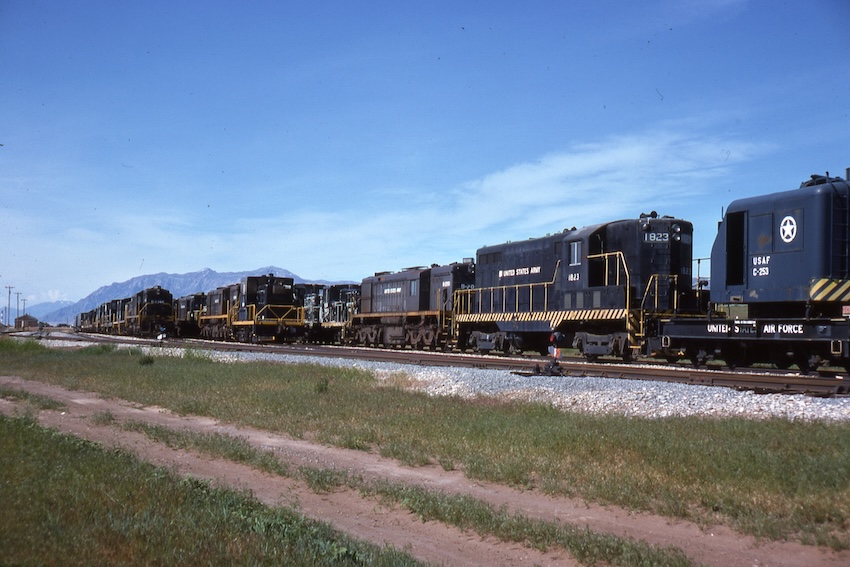 The Hill deadine on 30 may1976 | |
The U.S. military has long operated one of the largest locomotive fleets in the country.
Massive buys of power in both World War II and the Korean War led to hundreds of units working
in largely reclusive locations, mostly in an industrial environment but, in some places, as
functional shortlines where they ran to interchanges with Class 1 operations.
In order to maintain this growing fleet in 1939 the Army opened a locomotive shop at Ogden Arsenal on Hill Field (later Hill Air Force Base) located just south of Ogden, Utah. By the end of World War II it handled Army railroad maintenance west of the Mississippi River while a similar facility at Fort Holabird, Maryland, covered everything East. In 1949 the shop became a tenant on Hill AFB while administratively coming under the Tooele Army Depot (a base located further west in Utah). In 1964 it became the only Army locomotive maintenance facility in the nation as the Maryland shop was closed. In 1994 the shop was renamed the Defense Non-Tactical Generator and Rail Equipment Center. It would continue through 2019 when their functions started being transferred to a new facility at the Anniston (Alabama) Army Depot, which formally opened in June 2022. During the 1970s I was able to make several visits to the base and shoot the deadline they had on base. This place was akin to finding an elephant graveyard as it was full of exotic power in a wide range of condition. Some would be rebuilt for further use throughout the country with both the Army and Air Force. Others would be scrapped or donated to museums. Where else could you see locomotives from EMD, GE, Baldwin, Alco, Davenport and Fairbanks-Morse all in one location? | |
The Army bought almost 100 Davenports over the years, ranging from 10 to 80 tons. Their last
buy was 20 360HP centercabs during the Korean War, among them 1218 (3366 7/53) They may have
been a 'consolation prize' for not being awarded the contract for what became the large BLH
RS-4-TC buy. 1218 was photographed on 30 May 1976. It would end up being donated to the Heber
Valley RR in Utah.
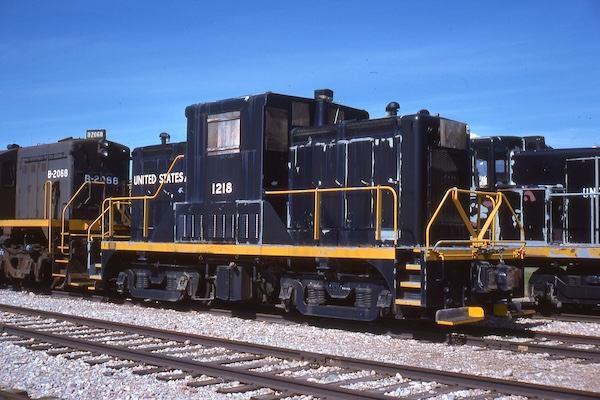 |
Air Force GE 44 tonner 1244 (31882, 2/53) on 30 May 1976. It was a late
44-tonner, as noted by the hood door beading and rectangular headlight mounts. It's painted in
USAF blue and carries the badge of the Tactical Air Command (TAC) from its time at MacDill
and Homestead AFBs in Florida. The unit reportedly later worked at Grissom AFB in Indiana. blank
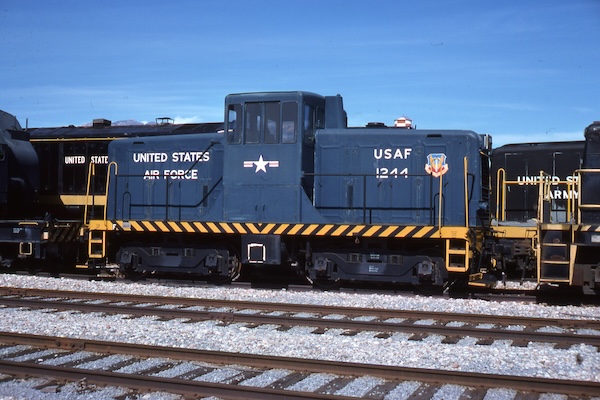 |
A definite "fixer upper" is GE 65 tonner 1403 (15249, 3/42) shot on 30 May 1976.
She was delivered to the Savanna (IL) Ordnance Depot while the war was still in question as
the country was fighting the Battle of the Atlantic and still recovering from the Pearl
Harbor attack in the Pacific. 1403 would reportedly be sold to dealer Houston Truck & Electric.
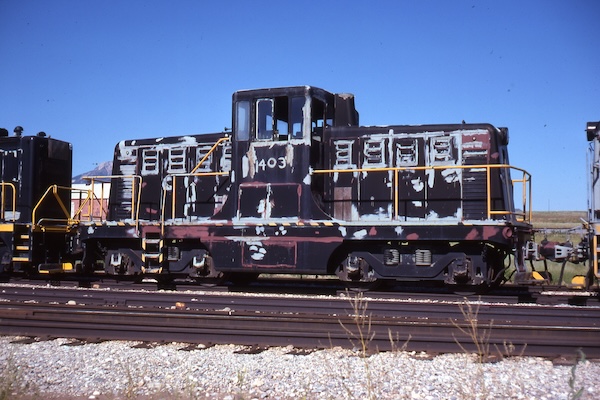 |
As part of the Korean War buy the Army acquired 15 80-ton units from Davenport that were based
on a Porter design. These "Davenporters" were numbered 1621 to 1635. 1625 (3348, 10/52) was
photographed on 30 May 1976 in what appears to be original paint.
Blank  |
The Army bought a lot of GE 80-tonners, at least 142, of both the "long" style as well as
the post-WWII 'short' design. 1686 (31818, 3/53) is shown in fresh Air Force blue on 30 May
1976. It was delivered to Camp Savannah, GA (Fort Stewart) and would eventually work at Shaw
AFB, South Carolina. It would leave Hill and be assigned to Seymour-Johnson AFB in North
Carolina. 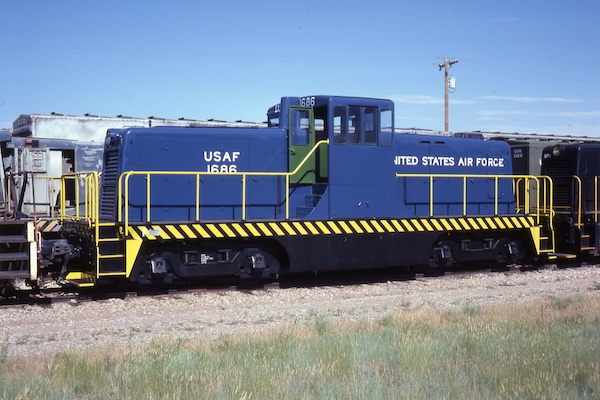 |
During the Korean War EMD built 13 1600HP units for the Army in 1952 under the company
designation MRS-1 ("Military Road Switcher-1"). These six-axle units were designed to operate
on foreign railroads in the event of war and equipped with steam boilers. Their price was over
$162,000 each, quite a sum for that day. 1820 (15885, 5/52) was photographed on 30 May 1976.
It appears to have spent most of its time at Fort Eustis in Virginia.
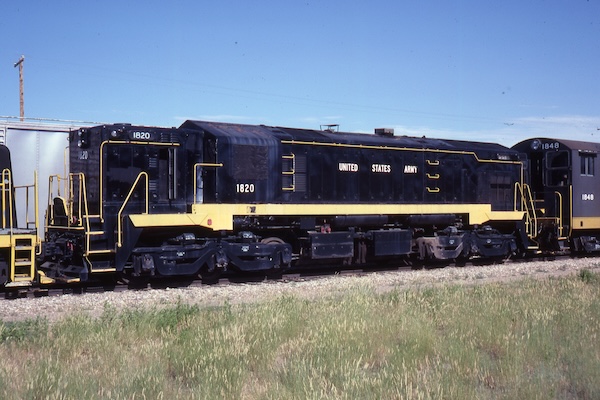 |
While the Army was buying MRS1s from EMD for foreign use it also bought 20 GP7s ("GP7L")
for use in the "ZI"", Zone of the Interior, or within the United States. They were basic GP7s,
with small 800-gallon fuel tanks and so-called AAR-A switcher trucks. 1823 was shot on 30 May
1976. It would be sold to the new SEMO Port Railroad at Scott City, Missouri, where it resides
in 2025, still in U.S. Army paint. |
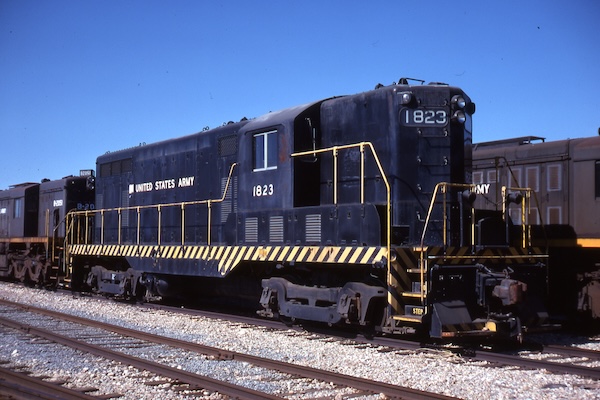 |
The Army sampled Fairbanks-Morse's product during the Korean War, buying 20 H-12-44 switchers.
1847 (12-L-671, 1/53) was photographed in 1976. The 1200-hp FM-built locomotive sports a small
"Transportation Corps" logo. was photographed in 1976. The 1200-hp FM-built
locomotive sports a small 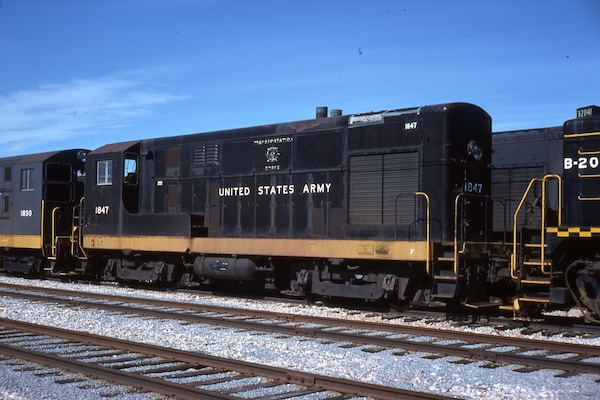 |
Along with the Army presence on Hill AFB in the '70s the Air Force ran a pair of Baldwin S-12s
on the base to conduct their own business. 1863 (75713, 12/52) was a former Navy unit and was
photographed on 16 August 1976 and wears appropriate Bi-Centennial markings as well.
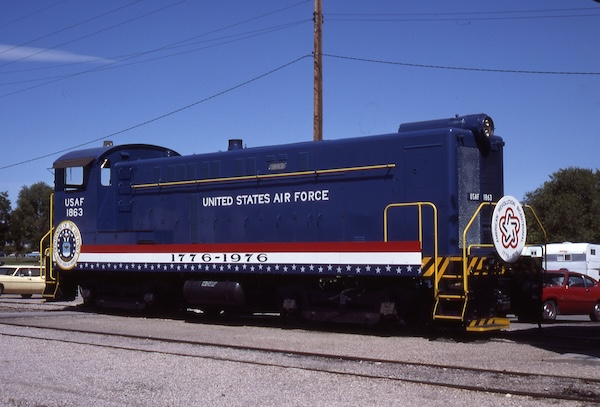 |
After buying 13 1500 HP six axle units from EMD, the Army ordered 83 similar locomotives from
GE while the Korean War was going on, apparently based on cost and delivery dates. GE contracted
with ALCO to build these locomotives at Schenectady, with the company term "RSX-4" being used.
In their technical documents the Army called them "120-ton, 1600-horsepower, diesel-electric
locomotive" with no model mentioned. Over the years the EMD-originated term "MRS-1" has been
applied to the ALCO design as well. This is B2081 on 30 May 1976, the "B" denoting a steam boiler
being installed. It operated for some period at Fort Bragg, North Carolina. |
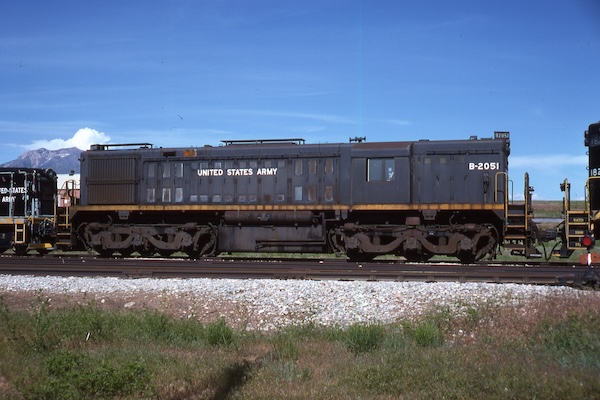 |
Not on the deadline but at the shop is the one-of-a-kind Davenport DE-48 number 4000 in June
1973 prior to being scrapped. The locomotive was supposed to be the first of many 48-ton
locomotives built for potential use overseas. Frustrating delays at Davenport led the Army to
contract Badlwin-Lima-Hamilton to construct 74 units to the same basic blueprint, the company
designating them RS-4-TC ("Road Switcher-4 axle-Transportation Command"), with the first one
being delivered at about the same time 4000 was. The Army considered 4000 as a 'prototype' and
the BLH units as 'production' models; both companies also finding that the Army specifications
raised weight to 60 tons, which is where they were rated. Contrary to lingering stories (and as
confirmed in Army and Baldwin documentation), there was no Whitcomb engineering content in the
Eddystone-built units, which were numbered in the 1200 (domestic service) and 4000 |
(foreign service) series. In the 1980s the Hill shops and two contractors rebuilt at least
40 of them into RS-4-TC-1As with new prime movers and roller bearings among other improvements.
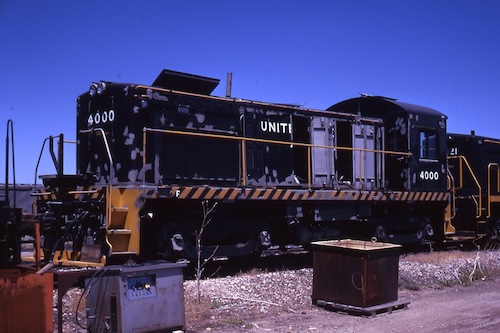 |
The Army bought 44 GE 44-tonners over WWII and Korea. 7095 (15126, 5/42) was delivered to
the Kentucky Ordnance Works near Paducah and end up as an Air Force unit before being sold
for scrap in 1980. It's shown here, a little worse for wear, on 30 May 1976.
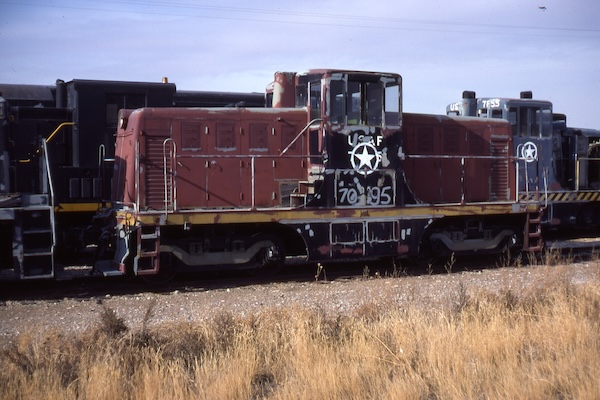 |
The Army ordered 27 Baldwin VO1000s during World War II. Air Force 7139 (67726, 7/43) was
shot at Hill in the summer of 1971. It had served at Ellsworth AFB in South Dakota for some
period and reportedly sold for scrap in 1974.
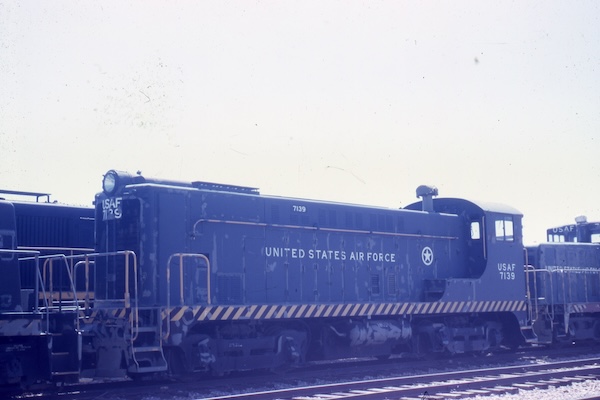 |
The Army acquired 16 Alco S1s. 7372 (69514, 11/41) and was stored at Hill in July 1971. It
originally worked at Lone Star Ordnance outside Texarkana Texas. Funding for the 7372 came
from the US Government's Defense Plant Corporation.
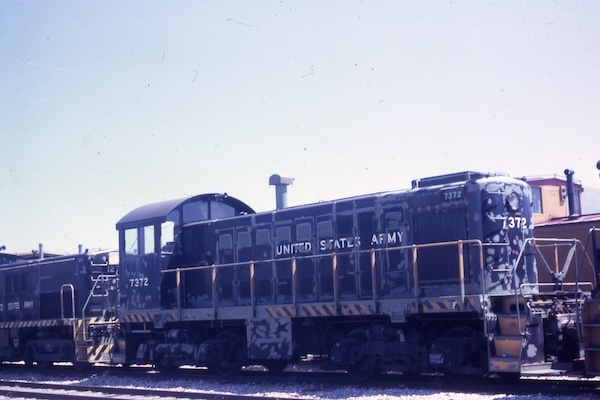 |
7376 (15671 8/42) is a classic "long" GE 80-tonner shot on 30 May 1976. It went to Plum
Brook Ordnance Works near Sandusky Ohio on delivery. That's a BLH RS-4-TC to its right;
behind appears to be a Strategic Air Command B-52 simulator car set.
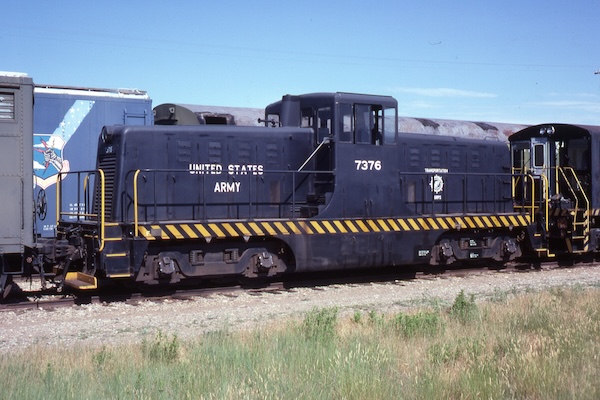 |
The Army bought 44 of the conventional General Electric 45 ton design. 7485 (13133, 6/41)
went to McClellan Field, Sacramento, California six months before the attack on Pearl Harbor.
It appears to have been the victim of target practice at some point. It was photographed on
24 December 1976. |
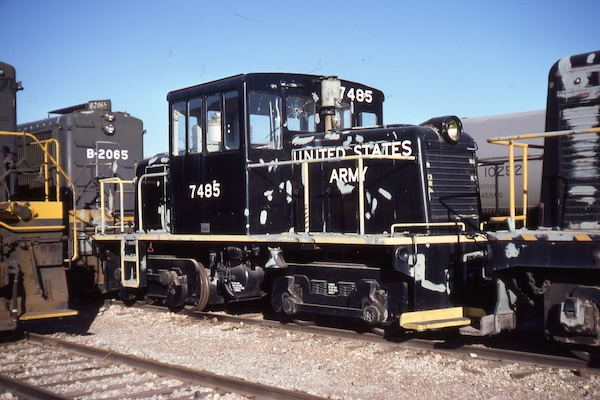 |
Among the locomotives ordered by the Army during World War II were a series of GE 44 tonners
built with lower cabs and other features that would allow their use overseas. 103 were acquired
with many of them being sent to Europe and Asia for work. They would later be described as "45
ton drop cabs" and many would return to the US for duty. 7929 (27636, 2/44) would actually be
delivered to the Engineering Depot at Granite City, IL opposite St Louis. It was photographed
on 30 May 1976. |
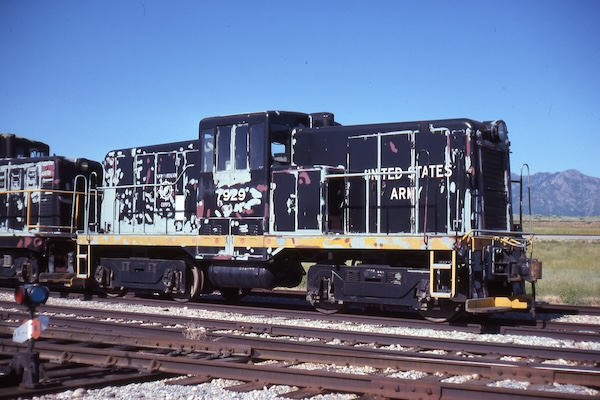 |
Hill deadline census, 30 May 1976: (47 total)
|
|
| New: 1 April 2025 | |